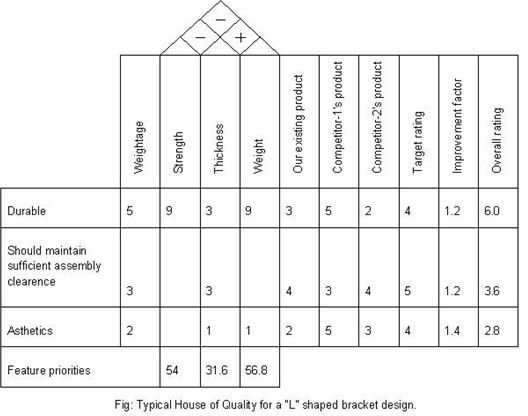Quality Function Deployment in Voice of the Customer
Quality Function Deployment (QFD) is some times roughly termed as House of Quality (HOQ). Actually, House of Quality is one of the techniques based on QFD. Further more, QFD itself is one of the tools of many available Six Sigma Tools.
What is QFD?
QFD is a methodology by which Voice of Customer (VOC) is converted to design parameters (or CTQ) for developing a new process or product.
Some popular QFD techniques
- Pugh Matrix: It is an important QFD tool for comparing different possible options and choosing the best one.
- House of Quality: House of Quality is a matrix which relates “What” to “How” (“What is the customer’s requirements?” to “How to achieve the requirements?”). Further on the basis of these relationships, design team can drilled down the design parameters or CTQ and can set design targets. Take a look at the attached snap of a typical HOQ ( Click on the snap to enlarge it):
At the left hand side of the snap, the first three rows represent “What” i.e., “What are customer’s requirements?”. At top, second, third and fourth columns represents “How” i.e., “How to achieve those requirements”.
First column is the weightage of each of the customer’s requirements. This need to be fixed by brainstorming among the team members.
Relation between individual “what” parameters to “How” parameters could be expressed by 9, 3 or 1. 9 mean strong relation, 3 medium and 1 week relation. For example, relation between “Durable” and “Strength” in the above HOQ is “Strong” and the relation between “Durable” and “Thickness” is week.
The fifth, sixth and seventh column of the HOQ represents rating of our existing product and two competitor’s products respectively against each of the customer’s requirements.
Eighth column “Target rating” is again decided by brainstorming on the basis of competitor’s product and our capabilities.
Ninth column of the HOQ is “Improvement factor”. It is calculated as: ((Target rating – Our existing product rating)*0.2) + 1)
Tenth column “Overall rating” is calculated as weightage* improvement factor.
Last row of the HOQ, “Feature priorities” is calculated by summing up the weighted relation of respective column. For example feature priority of “thickness” is calculated as: ((3*6) + (3*3.6) + (1*2.8)) = 31.6
Topmost triangle of the HOQ represents the interrelations between the design parameters. If the sign is “+” then by improving one parameter another parameter will improve and vice versa. For example, if we improve thickness (i.e., reduce it) of the bracket then the weight will also improve (i.e., reduce).
On the basis of customer requirements, interrelations between design parameters and the feature priorities values design team has to brain storm and set the target design parameters values.
Conclusion
QFD is an important Six Sigma methodology to convert VOC to CTQ. Many tools are available for QFD. HOQ and Pugh matrix are some of them.
